ASUS X99-A Motherboard Review
by Ian Cutress on December 22, 2014 2:00 PM EST- Posted in
- Motherboards
- Intel
- Asus
- Haswell-E
- LGA2011-3
System Performance
Power Consumption
Power consumption was tested on the system while in a single MSI GTX 770 Lightning GPU configuration with a wall meter connected to the OCZ 1250W power supply. This power supply is Gold rated, and as I am in the UK on a 230-240 V supply, leads to ~75% efficiency > 50W, and 90%+ efficiency at 250W, suitable for both idle and multi-GPU loading. This method of power reading allows us to compare the power management of the UEFI and the board to supply components with power under load, and includes typical PSU losses due to efficiency. These are the real world values that consumers may expect from a typical system (minus the monitor) using this motherboard.
While this method for power measurement may not be ideal, and you feel these numbers are not representative due to the high wattage power supply being used (we use the same PSU to remain consistent over a series of reviews, and the fact that some boards on our test bed get tested with three or four high powered GPUs), the important point to take away is the relationship between the numbers. These boards are all under the same conditions, and thus the differences between them should be easy to spot.



It would seem that the X99 motherboards are filtering into several bands of peak load power usage, around 200W, 210-220W and 240W+. The ASUS fits into the low end of that middle band.
Windows 7 POST Time
Different motherboards have different POST sequences before an operating system is initialized. A lot of this is dependent on the board itself, and POST boot time is determined by the controllers on board (and the sequence of how those extras are organized). As part of our testing, we look at the POST Boot Time using a stopwatch. This is the time from pressing the ON button on the computer to when Windows 7 starts loading. (We discount Windows loading as it is highly variable given Windows specific features.)
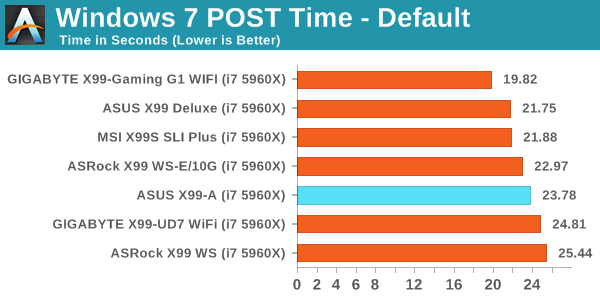
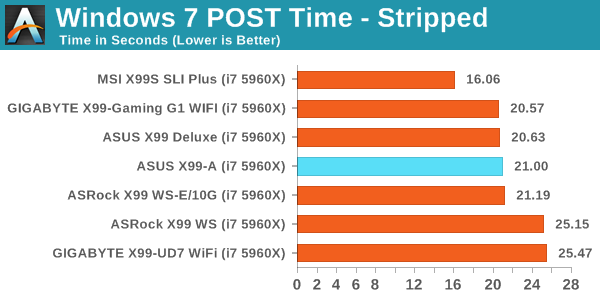
POST Times of all X99 motherboards are around the 20-25 second mark, and on the BIOS we used we saw almost 24 seconds.
Rightmark Audio Analyzer 6.2.5
Rightmark:AA indicates how well the sound system is built and isolated from electrical interference (either internally or externally). For this test we connect the Line Out to the Line In using a short six inch 3.5mm to 3.5mm high-quality jack, turn the OS speaker volume to 100%, and run the Rightmark default test suite at 192 kHz, 24-bit. The OS is tuned to 192 kHz/24-bit input and output, and the Line-In volume is adjusted until we have the best RMAA value in the mini-pretest. We look specifically at the Dynamic Range of the audio codec used on board, as well as the Total Harmonic Distortion + Noise.
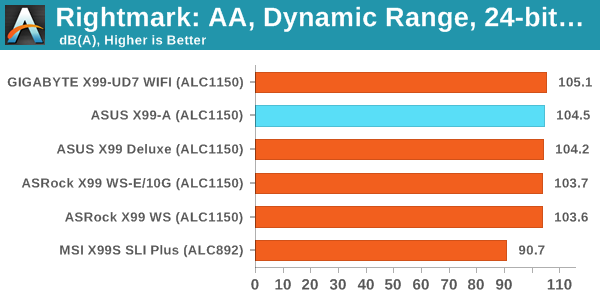

The X99-A performs extremely well in our audio testing, scoring some of the best results we have ever seen.
USB Backup
For this benchmark, we transfer a set size of files from the SSD to the USB drive using DiskBench, which monitors the time taken to transfer. The files transferred are a 1.52 GB set of 2867 files across 320 folders – 95% of these files are small typical website files, and the rest (90% of the size) are small 30 second HD videos. In an update to pre-Z87 testing, we also run MaxCPU to load up one of the threads during the test which improves general performance up to 15% by causing all the internal pathways to run at full speed.
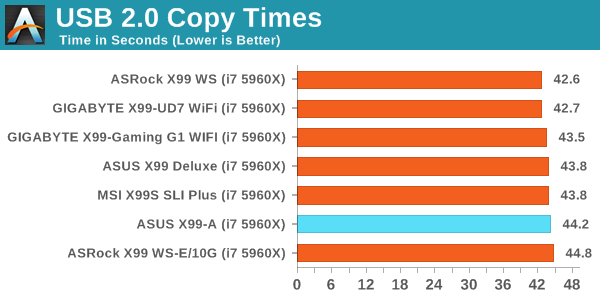
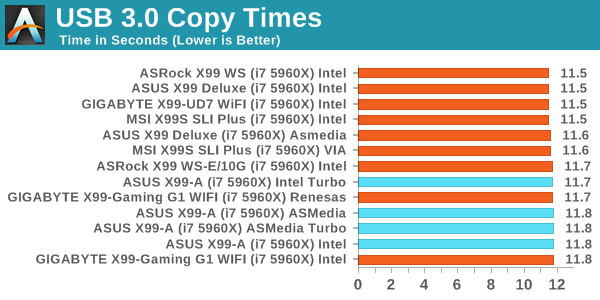
USB performance was on the low end compared to our other motherboards tested.
DPC Latency
Deferred Procedure Call latency is a way in which Windows handles interrupt servicing. In order to wait for a processor to acknowledge the request, the system will queue all interrupt requests by priority. Critical interrupts will be handled as soon as possible, whereas lesser priority requests such as audio will be further down the line. If the audio device requires data, it will have to wait until the request is processed before the buffer is filled.
If the device drivers of higher priority components in a system are poorly implemented, this can cause delays in request scheduling and process time. This can lead to an empty audio buffer and characteristic audible pauses, pops and clicks. The DPC latency checker measures how much time is taken processing DPCs from driver invocation. The lower the value will result in better audio transfer at smaller buffer sizes. Results are measured in microseconds.
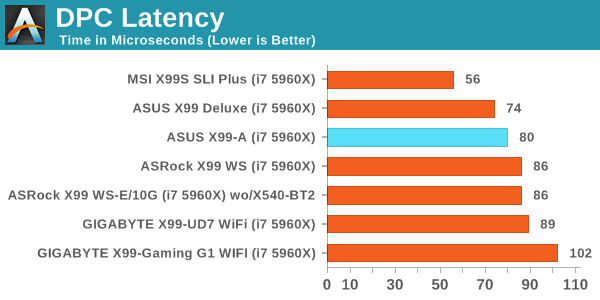
All X99 motherboards are aiming at the sub-100 microsecond category, and the X99-A fits in there with a score of 80.











37 Comments
View All Comments
stambous - Friday, December 26, 2014 - link
"In terms of performance the system does not implement Multicore Turbo, meaning that stock performance is down compared to some other products but a simple click on the TPU switch avoids this with a small 3.9 GHz overclock".I can syncronise all cores for turbo in BIOS and when CPU is under load all 8cores works on 3,5GHZ in stock config without OC.
kenshinco - Monday, December 29, 2014 - link
...and how did you do it? What settings did you set?stambous - Friday, January 2, 2015 - link
Very simply go to Adavnce mode in BIOS.Then Ai tweaker menu.You will see there CPU core ratio select from auto to "sync all cores".And thats it from this point all eight cores always work under load at 3,5GHZ instead of standard Intel turbo.Dont forget set under CPU settings C states from auto to "enabled".This will downclock CPU when idle.You dont want have always in idle all cores at 3,5GHZ:-)
stambous - Friday, January 2, 2015 - link
And what is best when you have sync all cores you can under Windows on Ai suite set higher ratio to all ocres too and have overclocked all cores together.My CPU is stable at 3,7GHZ all cores synced with stock voltages.I can go further and higher but at higher freq 3,8+ i need put voltages higher which i dont want.Iam good with small moderate OC at 3,7GHZ for all cores with stock voltages and low temps.microline - Saturday, July 4, 2015 - link
Will this board support Windows r2 Server OS?Endre18 - Monday, July 20, 2015 - link
Hey!I just recently bought a Asus x99-A/3.1 and im wondering if i can connect a thunderbolt ex II card onto it?
from what i can read at the Asus homepage it is not compatible...
Thanks in advance!
Equinox--- - Thursday, August 20, 2015 - link
I´ve used this card in my new rig for a couple of months now together with i75820, and have Antec Kuhler watercooling, using it together with the new ASUS STRIX GTX980ti 6GB Gaming, and both gaming and other more demanding tasks, as photo editing etc, runs exceptionally smooth. I can´t really see the point in shelling out for a deluxe-version for maybe 100$ more, thinking that it will seriously outperform this card in most processes. Overclocking this is a joy, watercooling should certainly be used in that case.Highly recommended!